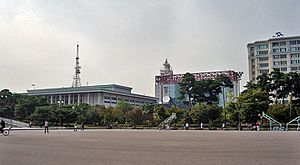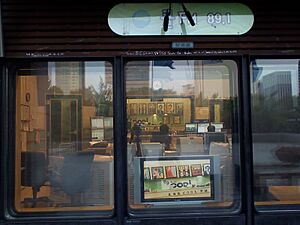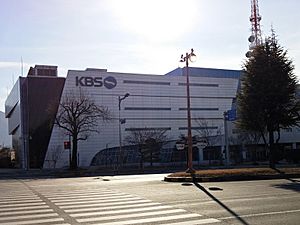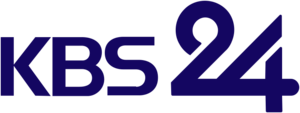Korean Broadcasting System facts for kids

Main building of the Korean Broadcasting System
|
|
|
Native name
|
|
|---|---|
| Hangul |
한국방송공사
|
| Hanja |
韓國放送公社
|
| Revised Romanization | Hanguk Bangsong Gongsa |
| McCune–Reischauer | Han'guk Pangsong Kongsa |
| Statutory corporation | |
| Industry | Public broadcasting |
| Predecessors |
|
| Founded |
|
| Founder | Governor-General of Korea |
| Headquarters |
Yeouido, Yeongdeungpo District, Seoul
,
South Korea
|
|
Area served
|
Worldwide |
|
Key people
|
Park Jang-beom (President and CEO) |
| Products |
|
| Owner | Government of South Korea |
|
Number of employees
|
4,701 (As of 1 June 2020) |
| Subsidiaries |
|
The Korean Broadcasting System (KBS) is the main public TV and radio broadcaster in South Korea. It was started in 1927. KBS is one of the biggest TV and radio companies in South Korea. It is supported by the South Korean government.
KBS runs seven radio networks and ten TV channels. It also has many online services. Its main TV channel, KBS1, is on channel 9. KBS2, which focuses on entertainment, is on channel 7. KBS also has an international service called KBS World. This service offers TV, radio, and online content in 12 different languages.
Contents
KBS History: How It Started and Grew
Early Days of Radio Broadcasting
KBS began as Gyeongseong Broadcasting Station on February 16, 1927. It used the call sign JODK. In 1932, it became the Chōsen Broadcasting Corporation. After Korea became free from Japanese rule, the station changed its call sign to HLKA in 1947. In 1948, it was renamed Seoul Central Broadcasting Station.
Television Arrives in the 1950s and 1960s
Television broadcasts in South Korea started on May 12, 1956, with HLKZ-TV. KBS bought this station in 1961. This marked the beginning of KBS's journey into television.
Growing Bigger in the 1970s
On March 3, 1973, KBS changed its goal. It became a public broadcaster, focusing on serving the people. Construction of the KBS headquarters in Yeouido began in 1976. In 1979, KBS radio started broadcasting on the FM band with KBS Stereo, now called KBS 1FM. Color television broadcasts also began that year.
Changes in the 1980s: Advertising and Mergers
KBS started showing advertisements in 1980. This was different from most public broadcasters. This happened after several private broadcasters were combined with KBS. This was done by the government at the time.
A new law in 1980 made public broadcasters merge with KBS. This included Tongyang Broadcasting Corporation (TBC) and Dong-A Broadcasting System (DBS). The Munhwa Broadcasting Corporation (MBC) was also affected. MBC was a group of many stations. After the changes, MBC stations had to give most of their shares to MBC Seoul. MBC Seoul then had to give 65% of its shares to KBS. In 2011, TBC and DBS were brought back as JTBC and Channel A.
The 1990s: New Channels and No Ads
In 1981, KBS launched KBS 3TV and Educational FM. On December 27, 1990, these two channels became a separate company. This new company is now known as the Educational Broadcasting System (EBS).
After a change in how TV license fees were collected in 1994, 1TV and Radio1 stopped showing commercials completely.
The 2000s and Beyond: Digital Age
KBS 2FM was not allowed to show ads from 1980 until 2002. In 2002, ads started airing again on this channel.
KBS began broadcasting in HD in 2001. By 2012, KBS had fully switched to digital broadcasting.
In 2013, some South Korean TV stations, including KBS, experienced computer shutdowns. The government said North Korea was involved in these cyberattacks. North Korea denied this.
In 2013, KBS World Radio celebrated its 60th anniversary. KBS World TV also celebrated 10 years since it started.
In 2014, KBS World 24 was launched. This channel is mainly for Koreans living in other countries.
In 2015, KBS's old broadcasts of Finding Dispersed Families were added to the UNESCO Memory of the World Register. This program helped families separated by the Korean War (1950–1953) find each other. It was a very important program that lasted for 138 days.
In 2017, KBS started the world's first terrestrial UHD broadcasting service. UHD means Ultra High-Definition, which offers very clear pictures.
In June 2018, KBS helped manage the International Broadcasting Centre (IBC). This was for the April 2018 inter-Korean summit. KBS showed live coverage of the historic meeting. This coverage was seen by many media groups from around the world. KBS World TV also provided live coverage with English subtitles for viewers in 117 countries.
In May 2019, KBS improved its Disaster Broadcast System. This system helps provide emergency information during disasters. It uses all of KBS's resources to give quick and helpful information. KBS also works to provide sign language interpreters for people with disabilities. They also improve English subtitles for international viewers.
How KBS Works
KBS is a public company that runs on its own. It gets money from the South Korean government and from license fees. The president of KBS is chosen by the President of South Korea. This person is suggested by KBS's board of directors. Political parties can also suggest people for the board.
About 49% of KBS's money comes from a required TV license fee. The rest comes from selling advertisements.
KBS has 18 regional stations and 12 offices in other countries. It also has eight smaller companies. These companies, like KBSN and KBS Media, help manage KBS content.
KBS Leaders: A Look at Past CEOs
| Generation | Name | Start | Retirement | Note |
|---|---|---|---|---|
| 1 | Hong Kyung-mo | February 1973 | February 1979 | N/A |
| 2 | ||||
| 3 | Choi Se-kyung | February 1979 | July 1980 | |
| 4 | Lee Won-hong | July 1980 | February 1985 | |
| 5 | ||||
| 6 | Park Hyun-tae | February 1985 | August 1986 | |
| 7 | Jung Koo-ho | August 1986 | November 1988 | |
| 8 | Seo Young-hoon | November 1988 | March 1990 | |
| 9 | Seo Ki-won | April 1990 | March 1993 | |
| 10 | Hong Doo-pyo | March 1993 | April 1998 | |
| 11 | ||||
| 12 | Park Kwon-sang | 20 April 1998 | 10 March 2003 | |
| 13 | ||||
| 14 | Seo Dong-koo | 22 March 2003 | 2 April 2003 | |
| 15 | Jung Yeon-joo | 28 April 2003 | 11 August 2008 | Left the role |
| 16 | ||||
| 17 | ||||
| 18 | Lee Byung-soon | 28 August 2008 | 23 November 2009 | N/A |
| 19 | Kim In-kyoo | 24 November 2009 | 23 November 2012 | |
| 20 | Kil Hwan-young | 23 November 2012 | 10 June 2014 | Left the role after a strike |
| 21 | Jo Dae-hyun | 28 July 2014 | 23 November 2015 | N/A |
| 22 | Ko Dae-young | 24 November 2015 | 23 January 2018 | Left the role after a strike |
| 23 | Yang Seung-dong | 9 April 2018 | 23 November 2018 | N/A |
| 24 | 24 November 2018 | 9 December 2021 | ||
| 25 | Kim Eui-chul | 10 December 2021 | 12 September 2023 | Left the role |
| 26 | Park Min (journalist) | 12 November 2023 | 9 December 2024 | |
| 27 | Park Jang-beom | 10 December 2024 | present |
KBS Channels: TV and Radio
Terrestrial Television Channels
| Name | Logo | Description |
|---|---|---|
| KBS1 | This is KBS's main channel. It shows news, current events, educational programs, dramas, sports, and kids' shows. It started in 1961 as HLKA-TV. It is funded only by the license fee, so it has no commercials. You can watch it across the country on channel 9. | |
| KBS2 | This channel is for entertainment. It started in 1980. It replaced the Tongyang Broadcasting Company, which merged with KBS. KBS2 is on digital channel 7. It also shows live sports, kids' shows, and some news and dramas. | |
| KBS News 24 | This is KBS's news channel. It started in 2010 as an online channel. It was available on digital channel 7 from 2021 to 2023. After July 2023, it became a free streaming channel. | |
| KBS UHD | This is the Ultra High-Definition channel. It uses the ATSC 3.0 format for very clear pictures. It shows music videos, old TV series, and other programs. |
KBS1 and KBS2 switched to digital broadcasting on December 31, 2012. This means older analogue TV services were stopped.
Cable and Satellite Television Channels
KBS also has several channels available on cable and satellite:
- KBS Life – This channel focuses on culture and dramas.
- KBS Drama – This channel shows dramas.
- KBS N Sports – This channel is all about sports.
- KBS Joy – This channel features comedy and quiz shows.
- KBS Kids – This channel is made for children.
- KBS Story – This channel is for a female audience.
These channels are run by KBS N, which is a part of KBS.
KBS World: Reaching Audiences Globally
KBS World is KBS's international TV and radio service. It started on July 1, 2003. It broadcasts 24 hours a day. It includes news, sports, dramas, entertainment, and children's shows. KBS World TV is available in 32 countries. Over 40 million homes around the world can watch it. About 65% of its programs have English subtitles.
KBS World TV mostly shows programs from KBS1 and KBS2. It sends its signal through satellites. Local TV providers then send it to their viewers. KBS World TV also has a YouTube channel. It reached 10 million subscribers in May 2019 and 13.5 million in July 2020. You can also find KBS World TV on Facebook, Twitter, Instagram, and LINE.
KBS Korea, also known as KBS World 24, is another channel. It is made for Koreans who live outside of South Korea.
KBS Radio Channels
KBS operates several radio stations:
- KBS Radio 1 (711 kHz AM/97.3 MHz FM) – This station broadcasts news, current events, dramas, and cultural programs. It started in 1927.
- KBS Radio 2 (603 kHz AM/106.1 MHz FM) – This station plays popular music. It started in 1948.
- KBS Radio 3 (1134 kHz AM/104.9 MHz FM) – This station was re-launched in 2000. In 2010, it became a radio station for people with disabilities.
- KBS 1FM (93.1 MHz Classic FM) – This station plays classical and folk music. It started in 1979.
- KBS 2FM (89.1 MHz/DMB CH 12B Cool FM) – This station offers entertainment and news. It started in 1966.
- KBS Hanminjok Radio (6.015 MHz shortwave and 1170 kHz mediumwave) – This station started in 1975.
- KBS World Radio – This is South Korea's international radio service. The government directly funds it.
KBS Logo History
More About KBS
KBS works with many public television broadcasters around the world. These partners are in places like North and South America, Europe, Asia, and Oceania.
KBS Headquarters and Operations
KBS made some changes on March 1, 2019. These changes were to make better content and improve digital services. They created a new Content Production 2 Division. This division handles making shows, marketing, and content business. Its goal is to create great dramas and entertainment programs.
KBS also created a Public Service Media Strategy team. This team works on developing KBS's digital programs. The Digital Media department and Digital News department also expanded their roles. The 'Audience Relations Center' is now a main department. It works directly under the KBS President and CEO. This center focuses on improving services for viewers. It also creates ways for audiences to participate. Local Stations Management is now overseen by the KBS Executive Vice President. This change gives more freedom to regional stations.
See also
 In Spanish: Korean Broadcasting System para niños
In Spanish: Korean Broadcasting System para niños
- Educational Broadcasting System
- KBS World Radio
- KBS America
- KBS World Canada
- KBS Symphony Orchestra
- KBS Hall
- Television in South Korea
- Korean Central Broadcasting Committee (similar organization in North Korea)











